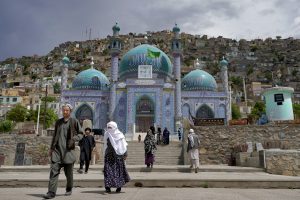Since the Taliban’s return to power in Afghanistan, respect for human rights and women’s rights has sharply declined. The detention, torture, and murder of journalists, the killing of opposition figures, and the closing of girls’ schools have all received international attention. Meanwhile, the Taliban’s failures in governance have created space for the Islamic State franchise in Afghanistan to relaunch a reign of terror against Hazara Shia.
Hazaras constitute the country’s third-largest ethnic group and largest religious minority community due to their Shia Muslim faith in the Sunni majority country. Hazaras are easily identifiable due to their different beliefs and features, and the local Islamic State franchise, known as IS-Khorasan Province (ISKP), has singled them out for years.
Safety was never assured, even when the United States and other countries were present in Afghanistan. The U.N. Mission to Afghanistan (UNAMA) documented 20 attacks against Hazaras in the first six months of 2021 before the Taliban returned to power, which killed 143 and injured more than 300. But conditions have worsened under Taliban misrule. In the past few weeks, ISKP and others unleashed a string of mass causality attacks against Hazaras.
In the span of 10 days in April, terrorists launched five attacks against Hazaras. They included bombing a boys’ school, the largest in the country, in a Hazara neighborhood in west Kabul on April 19. The following day ISKP claimed the bombing of a Hazara Shia mosque in Mazar-i-Sharif during prayers. One week later, in Mazar-i-Sharif, two different bombs targeting buses carrying Hazaras exploded. In nearby Samangan province, five Hazaras were pulled from a car and murdered.
While many tried to flee after the Taliban returned to power, the remaining community is reeling. These add to a death toll from last summer’s bombing of a girls’ school in Kabul.
I spoke with Akram Gizabi, president of the World Hazara Council, who described the community as “paralyzed” by the recurrent violence. “Our educated people are hiding or on the run. They need our help,” Gizabi said. “The problem is so severe we don’t know what to do.”
Hazara activists and intellectuals recently issued a public letter to U.N. Secretary General Antonio Guterres urging action. They called for a special session of the U.N. Security Council and the U.N. Human Rights Council on the plight of the Hazaras, as well as for the U.N. Special Rapporteur on Human Rights Situation in Afghanistan and UNAMA to collect information about crimes against humanity.
Others are pressing for a response. Analysts at the U.S. Institute of Peace recently highlighted ways to use the International Criminal Court (ICC) to ensure accountability for atrocity crimes in Afghanistan. The ICC has been investigating war crimes committed after July 2002. However, when the Taliban regained power, Karim Khan, the ICC prosecutor, announced that he would focus “on crimes allegedly committed by the Taliban and the Islamic State.” He argued such a focus was required due to the “gravity, scale and continuing nature of alleged crimes … which include allegations of indiscriminate attacks on civilians, targeted extrajudicial executions, persecution of women and girls, crimes against children and other crimes affecting the civilian population.”
Accountability is needed. But these efforts must have a special sensitivity for the Hazara community.
Hazara activists consistently speak of a “genocide” occurring against their community. The U.S. Holocaust Memorial Museum concluded that Hazaras are at “risk of crimes against humanity or even genocide,” noting that ISKP “view the Hazaras as a sworn enemy primarily because of their Shi’a faith.” While some may debate whether conditions meet the legal threshold found in the U.N. genocide convention, the Hazaras know they are being hunted and killed.
The options are few to help Hazaras left in Afghanistan. The international community must press the Taliban to protect Hazara gathering places. Such a request is deeply ironic considering the Taliban’s past oppression of Hazaras, but ISKP’s murderous campaign is the most urgent threat now. In this effort, the Organization of Islamic Cooperation (OIC) and its leading members should make this push, alongside other human rights concerns and women’s rights.
Lastly, the international community must find a way to help Hazaras escape to safety. Hazaras were 100 percent invested in the vision of Afghanistan the United States and others presented. Independent media, human rights groups, women’s education, and diversity of belief flowered during the past 20 years. Hazaras went to school and university, including women and girls, becoming part of the educated elite. Hazaras generally avoided creating militias. However, because of their more Western orientation and different Islamic denomination, their life in Taliban-ruled Afghanistan will be precarious at best, with bombings and attacks certain to continue.
Hazaras in Afghanistan face a bleak future, as do all Afghans living under Taliban rule. Consistent international pressure might bring the Taliban into line with the bare minimum of human rights standards, starting with letting women and girls attend school. In the same way, we must remember the unique needs of the long-beleaguered Hazara community, especially as they face persistent terrorist attacks.

































